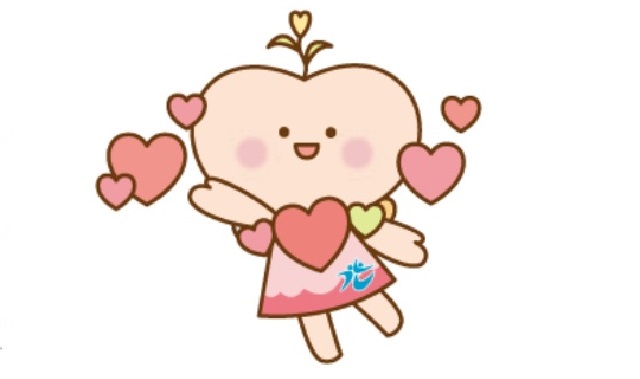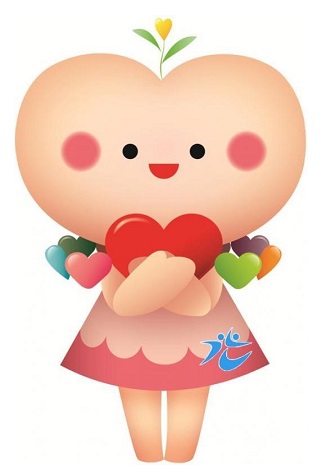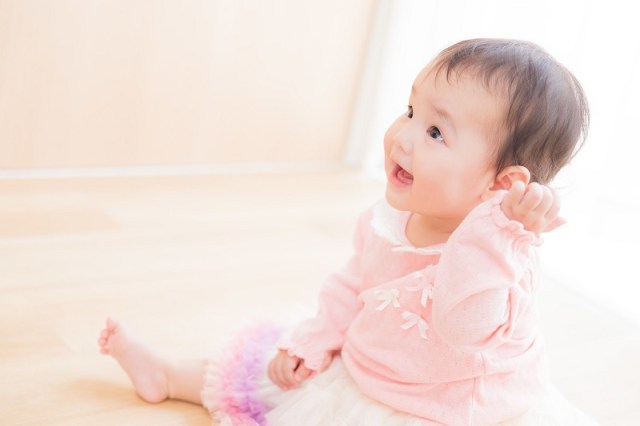
Kids in Hikari are raised under Boob Childrearing concepts.
Just about every city and region in Japan has some sort of local mascot character, and the town of Hikari, in Yamaguchi Prefecture, is no exception. So without further ado, allow us to introduce Cuto.
In keeping with Japanese character design sensibilities, Cuto is a mix of cute and quirky elements. Her name is even a pun, combining the English “cute” with kyutto, the Japanese onomatopoeia for giving something a loving squeeze, and in keeping with that affectionate atmosphere, she’s surrounded by colorful hearts.
Cuto’s head is sort of heart-shaped too, and she even has a girlish blush to her cheeks. Except, that might not actually be blush at all, because Cuto is an anthropomorphized pair of breasts.
▼ She’s even got her own dance, which involves bouncing and swaying.
「おっぱい都市宣言のまち」山口県光市が、「おっぱい都市宣言のまちイメージキャラクターきゅっと」なるゆるキャラを作ったらしい。https://t.co/XsaALGI6HZ 「みんなでおどろう!きゅっとちゃんダンス!」なるものも作られており、見てみたらすごかったw pic.twitter.com/wCaKCikdKJ
— 山口智美 (@yamtom) November 21, 2017
Cuto’s design inspiration is a little less startling if you happen to know that Hikari’s city council has issued what it calls the Oppai Toshisengen, or the City Boob Declaration. Of course, that declaration itself has a startling name, but it all makes perfect sense once you learn that it came about as a natural progression of the Oppai Ikuji/Boob Childrearing initiative, which started back in 1976…except now the brain just wants to know what the heck “Boob Childrearing” is, and it turns out it’s actually quite heartwarming.
In the early 1970s, baby formula was experiencing a rapid rise in popularity in Japan, thanks to its convenience factor. However, after looking at newer and newer medical reports, Hikarie’s city council realized that breast milk really is the healthier option for babies, and started a public awareness campaign to spread the word. In Japanese, the clinical term for breastfeeding is bonyu wo nomasu, but the colloquial phrase oppai wo nomasu, literally “let drink boob,” is also very common.
Eventually the breastfeeding awareness campaign expanded into a comprehensive movement encouraging parents to raise their children with all the love, care, and support they can, and since they’d already been talking about letting kids “drink boob,” Hikari just sort of rolled with the terminology and the movement and decided to call it Boob Childrearing.
There’s also metaphorical aspect to Boob Childrearing’s naming, as the less giggle-inducing word mune can mean either “breast” or “heart” (i.e. a person’s emotional core), and Cuto’s theme song even makes references to Dad’s and Grandpa’s boobs. The three core tenets of Boob Childrearing are “Watch,” “Hug,” and “Communicate,” with Hikari believing that paying attention to kids, showing the affection, and mentally engaging with them will help them feel loved, respected, and accepted, and that instilling such feelings in them from an early age will make them more likely to show the same compassion to others as they grew up.
All of this eventually led to the passing of the Hikari City Boob Declaration, which resolved that:
1. Through boobs, we will make Hikari a city that is kind to mothers, children, fathers, and all people.
2. We will hold our kids close to the warmth of chests, or boobs, raising them with love to be caring, healthy, shining children [Hikari means “light”or “shine” in Japanese]
3. We will help all mothers so that they can give bountiful boobs to their babies.
4. We will respect boobs, and protect and support the great mothers of our community.
The declaration was originally announced in 1995, and made once again in 2005. It hasn’t been officially renewed since, but by this point it seems like the city feels satisfied that it’s made its point that the value of boobs is eternal.
Even with Japan’s unabashed admiration of breasts, a lot of people are surprised when they first see Cuto or hear the name of the program she represents. But in a society that so often places so much emphasis on teaching kids to be responsible and hard-working, it’s honestly touching to see a community reminding parents that it’s just as important to make sure kids know that they’re loved and valued, even if it’s hard not to giggle at the name and mascot.
Sources: Hikari City (1, 2, 3), Real Live via Niconico News via Otakomu
Top image: Hikari City
Insert images: Hikari City, Pakutaso
● Want to hear about SoraNews24’s latest articles as soon as they’re published? Follow us on Facebook and Twitter!
Follow Casey on Twitter for more reasons to love Yamaguchi.



 Visiting Japan’s Gyarados Pokémon park in the city with a special connection to Magikarp【Photos】
Visiting Japan’s Gyarados Pokémon park in the city with a special connection to Magikarp【Photos】 Japanese vending machine serves up unique drinks at four Tokyo train stations
Japanese vending machine serves up unique drinks at four Tokyo train stations Pikachu’s chunky original design is back as a plus-sized plushie【Photos】
Pikachu’s chunky original design is back as a plus-sized plushie【Photos】 Massive manga collaboration bringing 100 years of Shueisha manga to Uniqlo T-shirts【Photos】
Massive manga collaboration bringing 100 years of Shueisha manga to Uniqlo T-shirts【Photos】 Which Japanese beef bowl chain’s near-identical demon grater onioroshi ponzu gyudon is the best?
Which Japanese beef bowl chain’s near-identical demon grater onioroshi ponzu gyudon is the best? Visiting Japan’s Gyarados Pokémon park in the city with a special connection to Magikarp【Photos】
Visiting Japan’s Gyarados Pokémon park in the city with a special connection to Magikarp【Photos】 Japanese vending machine serves up unique drinks at four Tokyo train stations
Japanese vending machine serves up unique drinks at four Tokyo train stations Pikachu’s chunky original design is back as a plus-sized plushie【Photos】
Pikachu’s chunky original design is back as a plus-sized plushie【Photos】 Massive manga collaboration bringing 100 years of Shueisha manga to Uniqlo T-shirts【Photos】
Massive manga collaboration bringing 100 years of Shueisha manga to Uniqlo T-shirts【Photos】 Which Japanese beef bowl chain’s near-identical demon grater onioroshi ponzu gyudon is the best?
Which Japanese beef bowl chain’s near-identical demon grater onioroshi ponzu gyudon is the best? Bear meat noodles?!? Tokyo restaurant adds a new kind of niku soba to its menu【Taste test】
Bear meat noodles?!? Tokyo restaurant adds a new kind of niku soba to its menu【Taste test】 Colorized photos of old-timey Philippines bring the past to life
Colorized photos of old-timey Philippines bring the past to life Bent postboxes in Taiwan are a heartwarming reminder to never give up
Bent postboxes in Taiwan are a heartwarming reminder to never give up The Yellow Lucky Bag from Village Vanguard is so bad it may damage Japan-US relations
The Yellow Lucky Bag from Village Vanguard is so bad it may damage Japan-US relations Canned cuteness as Hello Kitty and friends kick off Can Chara capsule toy line【Photos】
Canned cuteness as Hello Kitty and friends kick off Can Chara capsule toy line【Photos】 Starbucks Japan releases new drinkware and goods for Valentine’s Day
Starbucks Japan releases new drinkware and goods for Valentine’s Day Starbucks Japan releases new Frappuccino and latte for Valentine’s Day
Starbucks Japan releases new Frappuccino and latte for Valentine’s Day Our 52-year-old pole dancing reporter shares his tips for achieving your New Year’s exercise goal
Our 52-year-old pole dancing reporter shares his tips for achieving your New Year’s exercise goal Totoro cream puffs and Catbus cookies are finally available in downtown Tokyo
Totoro cream puffs and Catbus cookies are finally available in downtown Tokyo Majority of Japanese women in survey regret marrying their husband, but that’s only half the story
Majority of Japanese women in survey regret marrying their husband, but that’s only half the story Giant hotel rooms in Osaka reflect the new non-niche face of travel in Japan.
Giant hotel rooms in Osaka reflect the new non-niche face of travel in Japan. Japanese women showing rebounding interest in giving Valentine’s Day chocolate【Survey】
Japanese women showing rebounding interest in giving Valentine’s Day chocolate【Survey】 Japan’s kid-friendly ski program is now selling Pikachu snowboards for a limited time only
Japan’s kid-friendly ski program is now selling Pikachu snowboards for a limited time only Ramen restaurant’s English menu prices are nearly double its Japanese ones, denies discriminating
Ramen restaurant’s English menu prices are nearly double its Japanese ones, denies discriminating 10 times to avoid traveling in Japan in 2026
10 times to avoid traveling in Japan in 2026 Starbucks Japan ready to get Year of the Horse started with adorable drinkware and plushies【Pics】
Starbucks Japan ready to get Year of the Horse started with adorable drinkware and plushies【Pics】 7-Eleven Japan starts new temporary luggage storage service in over 300 branches
7-Eleven Japan starts new temporary luggage storage service in over 300 branches Disillusionment at Tsukiji’s tourist-target prices led us to a great ramen restaurant in Tokyo
Disillusionment at Tsukiji’s tourist-target prices led us to a great ramen restaurant in Tokyo Starbucks teams up with 166-year-old Kyoto doll maker for Year of the Horse decorations【Photos】
Starbucks teams up with 166-year-old Kyoto doll maker for Year of the Horse decorations【Photos】 Japan may add Japanese language proficiency, lifestyle classes to permanent foreign resident requirements
Japan may add Japanese language proficiency, lifestyle classes to permanent foreign resident requirements Survey asks foreign tourists what bothered them in Japan, more than half gave same answer
Survey asks foreign tourists what bothered them in Japan, more than half gave same answer Japan’s human washing machines will go on sale to general public, demos to be held in Tokyo
Japan’s human washing machines will go on sale to general public, demos to be held in Tokyo We deeply regret going into this tunnel on our walk in the mountains of Japan
We deeply regret going into this tunnel on our walk in the mountains of Japan Studio Ghibli releases Kodama forest spirits from Princess Mononoke to light up your home
Studio Ghibli releases Kodama forest spirits from Princess Mononoke to light up your home Major Japanese hotel chain says reservations via overseas booking sites may not be valid
Major Japanese hotel chain says reservations via overseas booking sites may not be valid Put sesame oil in your coffee? Japanese maker says it’s the best way to start your day【Taste test】
Put sesame oil in your coffee? Japanese maker says it’s the best way to start your day【Taste test】 No more using real katana for tourism activities, Japan’s National Police Agency says
No more using real katana for tourism activities, Japan’s National Police Agency says Starbucks Japan reveals new sakura drinkware collection, inspired by evening cherry blossoms
Starbucks Japan reveals new sakura drinkware collection, inspired by evening cherry blossoms Updated cherry blossom forecast shows extra-long sakura season for Japan this year
Updated cherry blossom forecast shows extra-long sakura season for Japan this year Bear meat noodles?!? Tokyo restaurant adds a new kind of niku soba to its menu【Taste test】
Bear meat noodles?!? Tokyo restaurant adds a new kind of niku soba to its menu【Taste test】 Colorized photos of old-timey Philippines bring the past to life
Colorized photos of old-timey Philippines bring the past to life Bent postboxes in Taiwan are a heartwarming reminder to never give up
Bent postboxes in Taiwan are a heartwarming reminder to never give up The Yellow Lucky Bag from Village Vanguard is so bad it may damage Japan-US relations
The Yellow Lucky Bag from Village Vanguard is so bad it may damage Japan-US relations Canned cuteness as Hello Kitty and friends kick off Can Chara capsule toy line【Photos】
Canned cuteness as Hello Kitty and friends kick off Can Chara capsule toy line【Photos】 Poké Ball cakes here for limited but long time to celebrate Pokémon franchise’s 30th anniversary
Poké Ball cakes here for limited but long time to celebrate Pokémon franchise’s 30th anniversary Majority of Japanese women in survey regret marrying their husband, but that’s only half the story
Majority of Japanese women in survey regret marrying their husband, but that’s only half the story New sushi restaurant hidden inside Tokyo Station is a secret gem
New sushi restaurant hidden inside Tokyo Station is a secret gem “Office lady in heels walking on tatami”: The mysterious world of Japanese fetishism
“Office lady in heels walking on tatami”: The mysterious world of Japanese fetishism Is the all-you-can-eat KFC buffet in Tokyo really as good as they say it is?
Is the all-you-can-eat KFC buffet in Tokyo really as good as they say it is? New Japanese vending machines to love: The ones that sell Hiroshima’s best dessert!
New Japanese vending machines to love: The ones that sell Hiroshima’s best dessert! Is the new Shinkansen Train Desk ticket worth it?
Is the new Shinkansen Train Desk ticket worth it?
Leave a Reply